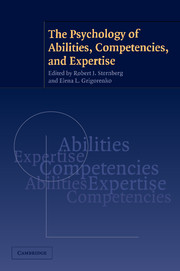Book contents
- Frontmatter
- Contents
- Preface
- List of Contributors
- The Psychology of Abilities, Competencies, and Expertise
- 1 Trait Complexes, Cognitive Investment, and Domain Knowledge
- 2 Intelligence as Adaptive Resource Development and Resource Allocation: A New Look Through the Lenses of SOC and Expertise
- 3 Developing Childhood Proclivities into Adult Competencies: The Overlooked Multiplier Effect
- 4 The Search for General Abilities and Basic Capacities: Theoretical Implications from the Modifiability and Complexity of Mechanisms Mediating Expert Performance
- 5 On Abilities and Domains
- 6 Expertise and Mental Disabilities: Bridging the Unbridgeable?
- 7 The Early Progress of Able Young Musicians
- 8 Expertise, Competence, and Creative Ability: The Perplexing Complexities
- 9 Biological Intelligence
- 10 What Causes Individual Differences in Cognitive Performance?
- Index
- References
9 - Biological Intelligence
Published online by Cambridge University Press: 05 June 2012
- Frontmatter
- Contents
- Preface
- List of Contributors
- The Psychology of Abilities, Competencies, and Expertise
- 1 Trait Complexes, Cognitive Investment, and Domain Knowledge
- 2 Intelligence as Adaptive Resource Development and Resource Allocation: A New Look Through the Lenses of SOC and Expertise
- 3 Developing Childhood Proclivities into Adult Competencies: The Overlooked Multiplier Effect
- 4 The Search for General Abilities and Basic Capacities: Theoretical Implications from the Modifiability and Complexity of Mechanisms Mediating Expert Performance
- 5 On Abilities and Domains
- 6 Expertise and Mental Disabilities: Bridging the Unbridgeable?
- 7 The Early Progress of Able Young Musicians
- 8 Expertise, Competence, and Creative Ability: The Perplexing Complexities
- 9 Biological Intelligence
- 10 What Causes Individual Differences in Cognitive Performance?
- Index
- References
Summary
Over the course of the years, there have been many diverse definitions of intelligence. A common feature of these definitions, however, has been intelligence as the ability to adapt to the environment (see, for example, “Intelligence and its Measurement,” 1921; Sternberg and Detterman, 1986). There is perhaps no other feature of definitions of intelligence that has this level of universality.
What has been left unclear in these definitions and in the theories based on them is exactly what adaptation to the environment means. I argue in this essay that there are two distinct senses of adaptation to the environment, and that their meanings are quite different. Both constitute kinds of intelligence, one biological, the other, cultural. The focus of this article is on the biological.
Before discussing the proposed view of biological intelligence, I briefly review some previous approaches on which any new view must build, or at least, with which any new view must come to terms.
BIOLOGICAL APPROACHES TO INTELLIGENCE
Biological approaches typically seek to understand intelligence by directly studying the brain and its functioning rather than by studying primarily products or processes of behavior (Jerison, 2000; Vernon, Wickett, Bazana, and Stelmack, 2000). Early studies, like those by Karl Lashley (1950) and others seeking to localize biological bases of intelligence and other aspects of mental processes, were a resounding failure, despite great efforts. But Lashley had only relatively primitive tools for studying the brain.
- Type
- Chapter
- Information
- The Psychology of Abilities, Competencies, and Expertise , pp. 240 - 262Publisher: Cambridge University PressPrint publication year: 2003



